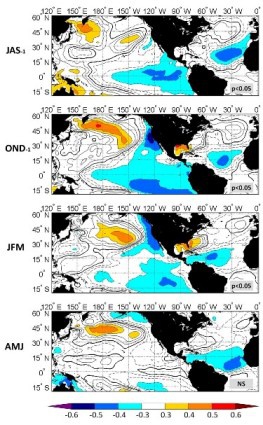|
|




Christopher J. Martinez, Ph.D
Use of Seasonal Climate Information to Forecast Agricultural Yields in the
Southeast USA
Christopher J. Martinez, Ph.D
279 Frazier Rogers Hall
PO Box 110570, University of Florida
Gainesville, FL 32611
279 Frazier Rogers Hall
PO Box 110570, University of Florida
Gainesville, FL 32611
Phone: (352) 392-1864 x279
Fax: (352) 392-4092
Email: chrisjm@ufl.edu
Fax: (352) 392-4092
Email: chrisjm@ufl.edu
Correlation of yields with SSTs
found by SVD analysis.
found by SVD analysis.
Sea surface temperatures (SSTs) can
provide valuable predictive information for
regional climate and agricultural yields in
many parts of the world. This study was
conducted to identify relationships between
Atlantic and Pacific SSTs and corn yields in
Alabama, Florida, and Georgia and to use
these relationships to develop forecasts that
can be used at lead times prior to spring
planting.
For this work, relationships between seasonal SSTs and detrended county corn yields were determined using singular value decomposition (SVD) analysis and confirmed using principal component analysis (PCA). A Monte Carlo approach was used to evaluate field-significance. Significant results found by SVD and PCA were then used to develop cross-validated models to forecast county yields.
This work found the strongest relationships between SSTs and yields to occur in the July–September (JAS-1) and October–December (OND-1) seasons, prior to spring planting (typically between March and May).
For this work, relationships between seasonal SSTs and detrended county corn yields were determined using singular value decomposition (SVD) analysis and confirmed using principal component analysis (PCA). A Monte Carlo approach was used to evaluate field-significance. Significant results found by SVD and PCA were then used to develop cross-validated models to forecast county yields.
This work found the strongest relationships between SSTs and yields to occur in the July–September (JAS-1) and October–December (OND-1) seasons, prior to spring planting (typically between March and May).
Using the cross-validated models 91.5% and 98.4% of forecasted
county corn yield residuals showed predictive skill (based on
tercile hit scores) with seasonal index values in the JAS-1 and
OND-1 seasons, respectively. The results of the models indicate
that the indices of SSTs show significant predictability with corn
yield residuals at lead times up to 4–7 months prior
to spring planting and are a significant improvement over models that use of an index of ENSO alone.
This work has been published in a journal article (link) as has a similar work using standard climate indices to forecast yields (link).
to spring planting and are a significant improvement over models that use of an index of ENSO alone.
This work has been published in a journal article (link) as has a similar work using standard climate indices to forecast yields (link).









